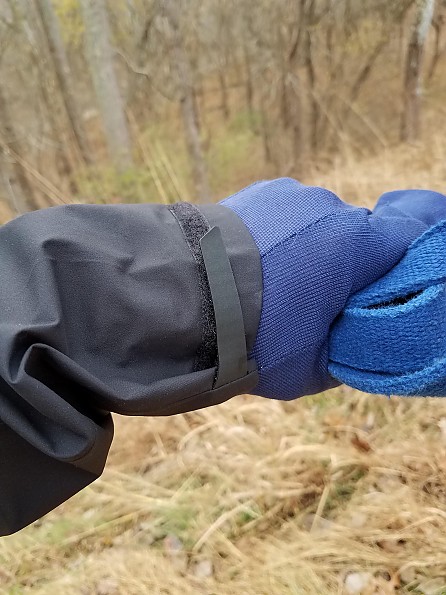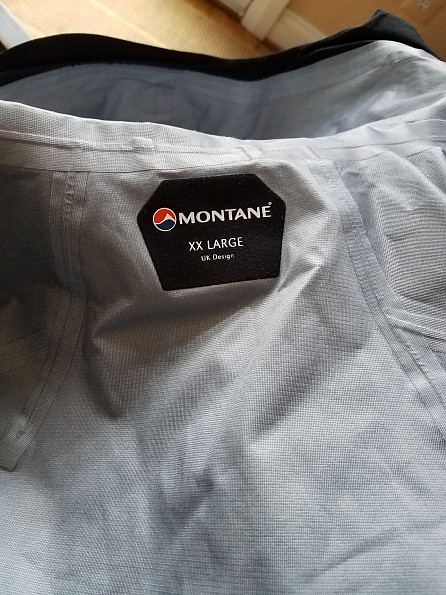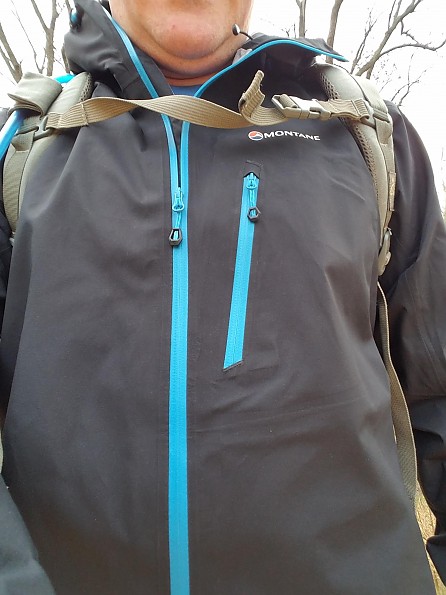Montane Spine Jacket

Montane's Spine Jacket is a Goretex shell that appears to be very well put together. It combines very light weight with essential functions—windproof, waterproof, cuff and hem adjustments, a good hood, and pit zips.
The jacket has an athletic cut that limits weight and allows for limited layering underneath and only one small chest pocket. If you truly want fast and light, it's a great jacket.
Pros
- Lightweight
- Wrist and hem adjustments
- Armpit zips/ventilation
- Waterproof/windproof
Cons
- Athletic cut not for everyone
- Only one small pocket
- Hood adjustments limited
BASIC INFORMATION AND HISTORY

A bit of history that may be of interest: this jacket is named after the Montane Spine Race, a 420 kilometer trail race in the UK that is run in mid-January, starting in the Peak District. Needless to say, the jacket is designed with those conditions in mind.
The Montane Spine Jacket I received through Trailspace is a size XXL. I normally wear extra large, a 46 jacket size, but I size up for brands made in the UK. That was a smart move here—XL would have been too small.
It weighs 250 grams on my electronic hand scale, that's 8.8 ounces. For a Goretex shell jacket, that is really lightweight. As a means of comparison, my Patagonia Alpine Houdini (waterproof, but a coated nylon, not as breathable) weighs 200 grams/7 ounces; Arcteryx's Alpha FL Jacket, a Goretex shell, has an average weight of 11.5 ounces.
The Spine retails for $399. (Worth noting that according to Montane, the average weight of the Spine is 10.2 ounces, so my scale could be slightly off).
FIT/COMFORT
This jacket has an athletic cut. The shoulders and torso are narrow and made with limited room to spare. The most I can wear without having my movement restricted is a T-shirt and a heavyweight base layer, Patagonia's expedition weight capilene shirt, for example.
Keep in mind, though, that I'm not a narrow person. The sleeves are modestly roomy, a touch long for my arms but perfectly fine. That added length means the sleeves don't hike up, and the jacket does not rise much, if I raise my arms high. The hem falls a few inches below my hip (I'm 5 foot 9).
The interior of this shell jacket is smooth. It slides easily over mid-layers. Pictured below.
FEATURES
The feature set is quite good for a light, minimalist shell jacket. The cuffs have narrow hook/loop tabs that work well sealing out rain. The only hood adjustment is the two side pulls, though the back of the hood is elasticized. It fits well over a wool hat; my sense is that it would not do well accommodating a helmet. 

The hem has an elastic cord that pulls tight to keep weather out—two pulls, one left, the other right. Interestingly, this jacket has armpit zips, unusual for a very light jacket like this. The zips are relatively short and have a good, non-slip tab that feels like synthetic leather. Most of the time, I had the zips open due to our relatively mild Maryland winter. 
All the zippers are waterproof and feel a tad sticky at first. That goes away after wearing the jacket and using the zippers. This doesn't mean the waterproof coating was compromised; a lot of waterproof zips start out a little 'tight,' which abates with some use. Like most UK brands, the main zipper pulls all the way down and disengages by pulling left-handed, unlike most U.S. brands.
The Spine has one chest pocket. It is smallish—enough for a smart phone and small energy food, nothing more. It has an interior port. You can park a music player in the pocket and run headphones into the pocket internally. There are no interior pockets.
VENTILATION
The front zip is the main form of mechanical venting, assisted by opening the armpit zips. The Goretex Active fabric does a great job limiting moisture buildup as well. To test breathability, other than the many hikes I took with the jacket, I hiked four or five miles on a breezy 50 degree afternoon, with temperatures cooling off. With a medium weight base layer underneath, I sweated some, but not as much as I expected, and the interior surface of the Spine was only a little damp.
WIND RESISTANCE
One of the coldest and most windy days we had recently, the temperature was in the low twenties and northwest winds were 30-35 miles per hour. I also wore the jacket on a sunny afternoon where the winds had to be 25 mph. Both times, the Spine Jacket proved to be an excellent wind barrier.
WATERPROOFING
Impeccable. On a couple of rainy morning hikes, I paired the Spine with some Goretex pants on one day, a pair of eVent pants the other. Rain was light to steady. Both hikes were pretty warm, I had a long sleeve base layer underneath with the pit zips open. I was happily dry throughout. Nice photo of precipitation beading up on the hood and shoulders. Worth noting that the hood works well at keeping the rain out; lateral visibility with this hood is somewhat limited.
Worth noting that the hood works well at keeping the rain out; lateral visibility with this hood is somewhat limited.
DURABILITY
Always a hard issue to address after three or four months of use. The seams all seem well-taped, and the fabric shows no wear despite at least thirty hours underneath pack straps. I washed the jacket twice, primarily for odor removal—gentle cycle, sport wash, dried in a dryer on low heat per manufacturer's instructions. No apparent impact from laundering either. The water repellant treatment on the surface was as good as new.
TESTING CONDITIONS
Fall and early winter in the Mid-Atlantic. Over the three or four months of testing, I spent 25-30 hours walking and hiking in this jacket, about 75-85 miles in and around Washington D.C., on trails by the Potomac River and on the hills/small mountains we're graced with in Maryland. In temperatures ranging from 20 to 50. A few rainy and windy days along the way. For the most part, I carried day packs with 15-25 pounds.
Even moving fast, I wouldn't want to wear this in temperatures colder than 20°. There just isn't enough room to add insulation, for me anyway. A narrower/trimmer person might be able to layer a little more underneath.
CONCLUSIONS
People who run and nordic ski in the winter will probably love this jacket. Marrying light weight with a jacket that repels very bad weather is very appealing. It is not meant for brutally cold weather, not enough ability to layer underneath, and I would want a hood that has better adjustability for winter conditions. People who like simplicity will also gravitate toward this jacket. If you like more options for interior or exterior storage, look elsewhere. Also, I wouldn't choose this jacket for winter climbing. The nylon fabric is sturdy but not meant to interact a lot with rock and ice.
I'm very impressed with how much function and performance Montane packed into a jacket that weighs so little (for size XXL), and by what appears to be a very solidly built jacket.
Source: received for testing via the Trailspace Review Corps
(Sample provided by Montane for testing and review)
Your Review
Where to Buy
You May Like
Specs
| Price |
MSRP: $399.00 Historic Range: $198.83-$399.95 |
| Weight |
291 g |






